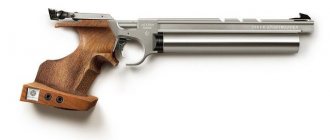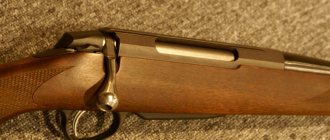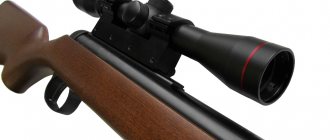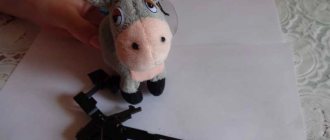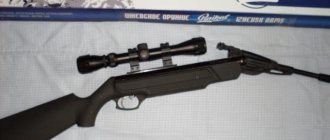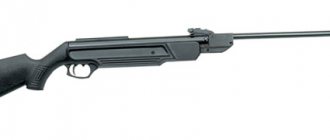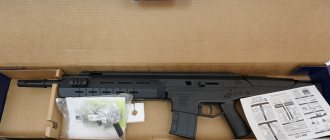TOZ-8 is a Soviet single-shot small-caliber rifle of 5.6 mm caliber (or .22 LR). Produced since 1932 at the Tula Arms Plant. The TOZ-8 rifle is distinguished by its simple design, trouble-free operation and high reliability. For many years it was used for initial shooting training in school shooting ranges and DOSAAF. In our time, it is still used by hunters in the Urals, Siberia and the Far East for hunting small game. Some structural elements of the TOZ-8 rifle are used in the designs of modern training and training rifles.
History of the creation of TOZ-8
The TOZ-8 rifle was created in 1932 at the Tula Arms Factory by the talented designer Dmitry Ivanovich Kochetov.
The predecessor of the TOZ-8 rifle was the TOZ-7 rifle, which was put into mass production in 1928, after some time it was modernized and received the designation TOZ-7A. The TOZ-8 rifle was created on the basis of the TOZ-7A rifle. In 1931, tests took place in Moscow for which rifles designed by D.I. Kochetov, A.A. were presented. Smirnsky and S.A. Korovina. Based on the results of these tests, the rifle designed by D.I. Kochetov was recognized as the best, which was put into mass production under the name TOZ-8.
The TOZ-8 single-shot small-caliber rifle immediately began to be supplied to OSOAVIAKHIM, and then to DOSAAF. Millions of Soviet people were trained to shoot from the TOZ-8 rifle.
The TOZ-8 rifle was produced without changes in design until the Great Patriotic War, after which production of a modernized version of the rifle began, called TOZ-8M. Based on the TOZ-8 single-shot rifle, a repeating rifle was created under the designation TOZ-9.
During the Great Patriotic War, the TOZ-8 single-shot rifle and the TOZ-9 multi-shot rifle were used by Soviet partisan formations.
Nowadays, the TOZ-8 small-caliber rifle is used by some hunters for hunting small game. The TOZ-8 rifle is especially common in the Urals and Siberia.
Literature
- P. S. Suranov, I. A. Blinkov. Basics of shooting small-caliber weapons. M., DOSAAF publishing house, 1952.
- M. V. Margolin. Repair of small-caliber sporting rifle TOZ-8. M., DOSAAF publishing house, 1955. - 84 pages.
- V. E. Yankovsky, A. B. Shadymov. Features of the entrance gunshot damage to the flat bones of the skull with a non-sheathed bullet when fired at an angle of 90° from a small-caliber TOZ-8 rifle of 5.6 mm caliber // journal “Forensic Medical Examination”, No. 3, 1987. pp. 7-10
- V. Glazatov, L. Spitzgauz. Small-caliber rifles TOZ-8 and TOZ-9 // “Arms and Hunting” magazine, No. 9-10, 2009
- Sergey Yurchuk, Mikhail Konoplev. TOZ-8 and TOZ-12 // “Weapons and Hunting” magazine, No. 1, January 2011
- Victor Ron. TOZ-8M - the first Tula small-caliber hunting rifle // "Weapons" magazine, No. 4, 2016
Characteristics of TOZ-8
- Rifle weight:
3120 grams - Overall rifle length:
1110 mm - Barrel length:
640 mm - Rifle caliber:
5.6 mm - Number of grooves:
4 - Rifling pitch:
350 mm - Initial bullet speed:
280-350 m/s - Sighting range:
250 meters - Distance to maintain the lethal force of a bullet:
800 meters - Maximum bullet range:
1200-1600 meters - Operating principles :
sliding bolt
Modifications
- TOZ-8
is the basic model of the rifle, produced from 1932 until the end of the Great Patriotic War - TOZ-8M
is a modified version of the rifle, production began after the end of the Great Patriotic War. Unlike the basic modification of the rifle, the TOZ-8M rifle has a sector-type sight, which allows it to be adjusted in height. The front sight is equipped with a ring earpiece. The bolt of the TOZ-8M rifle has a smaller diameter bolt and does not have a clutch, making the rifle more convenient to reload. The rifle stock has a wider fore-end. - TOZ-9
is a magazine version of the rifle, developed in 1933 by designer D.I. Kochetov based on the TOZ-8 rifle. The TOZ-9 rifle has a box magazine that holds 4 cartridges, the fifth cartridge is in the chamber. The magazine is located inside the rifle stock, is inserted from below and is secured against falling out with a latch. - TOZ-11
is a lightweight version of the rifle developed in 1946 by designer K.I. Shikhvatov especially for commercial hunters. Produced from 1946 to 1957. Rifle weight 2 kg. The rifle had a new birch stock. - TOZ-12
rifle model was developed by designer D.M. Kochetov based on the TOZ-8 rifle. - TOZ-16
is a rifle created on the basis of the TOZ-8M rifle, taking into account the experience gained in the production and use of the TOZ-11 rifle. Many parts of the rifle are borrowed from the TOZ-8M rifle.
In order to find out the year of manufacture of the TOZ-8 rifle, just look at the stamp on the barrel box; before 1986, the year of manufacture of the rifle was indicated by a letter code, and after 1986, by two numbers in front of the serial number of the rifle.
Trunk
The TOZ-8 rifle has a cylindrical barrel of great thickness, the length of the rifle barrel is 640 mm. There are four screw grooves inside the barrel. The rifling pitch is 350 mm.
In the front part of the barrel there is a longitudinal groove into which the base of the front sight is installed. There are two longitudinal grooves in the rear part of the barrel; they are used for attaching the sighting block. At the back of the barrel there is also a special stump to which the receiver is attached using a pin.
Receiver
The receiver of the TOZ-8 rifle looks like a simple pipe, which looks like an extension of the barrel. Inside the receiver there is a bolt, the receiver also serves as the basis for the firing mechanism. A wooden stock is attached to the bottom of the receiver.
On the right side of the receiver there is a shaped cutout along which the bolt handle guide moves.
On the right side of the receiver, in front of the figured cutout, there is a window that is needed for inserting a cartridge and ejecting spent cartridges. Two holes were drilled next to it, designed to remove escaped powder gases.
At the rear of the receiver there is a special removable cap that performs three important functions:
- The cap closes the receiver channel and thereby protects it from contamination
- The installed cap eliminates the possibility of the shutter falling out
- The cap protects the shooter's eye in the event of a breakthrough of powder gases into the receiver channel.
At the bottom of the receiver there is a pyramidal stop designed to secure the barrel and receiver with a wooden stock.
Inside the receiver there is a liner that is secured with a screw. The insert guides the cartridge into the rifle's chamber when loading, deflects the spent cartridge case when ejecting, and guides the bolt when moving forward.
Gate
A longitudinally sliding rotary bolt moving inside the receiver is needed to send a cartridge into the chamber, lock the barrel, fire a shot and eject the spent cartridge case from the chamber.
The bolt of the TOZ-8 rifle consists of a combat cylinder, a bolt stem with a handle, a trigger, a firing pin with a striker, a mainspring and a coupling.
Combat cylinder - designed to connect all parts of the bolt into a single whole. Inside the combat cylinder there is a channel in which the firing pin and the mainspring are located. The combat larva has a special cup for placing the cartridge cap. On the right and left of the combat cylinder there are grooves for the ejector and sleeve deflector. In the front part of the combat cylinder there is a protrusion that serves as a cartridge rammer. In the rear part of the combat cylinder there is a stump with a hole for putting on the bolt stem with a handle.
The bolt stem with a handle is necessary for ease of operation of the bolt. Has two small and two large cutouts.
Ejector - used to remove the spent cartridge case from the chamber and throw it through the window in the receiver.
The sleeve deflector is intended to fix the cartridge in the cup of the bolt cylinder.
The firing pin is needed to strike the cartridge case to fire a shot. A mainspring with a coupling is put on the firing pin.
Trigger - necessary to keep the firing pin cocked. There is a hole inside the trigger for screwing onto the firing pin, which is additionally secured with a pin.
The TOZ-8 rifle does not have lug lugs; the bolt is locked using the loading handle.
The design and principle of operation of the gun
Detachable trunks are located in a horizontal plane. The barrel channels are chrome-plated and have different choke constrictions. The connection and locking of the barrels with the box is carried out by means of a hinge axis, barrel hooks, a locking frame, a transverse pin and a forend.
The upper sighting bar does not reach the rear end of the barrels by 23-25 mm and forms a tin-soldered and guilloched joint with the small hook.
Parts of the trigger and impact mechanisms are mounted on separate bases. The working compression of the mainspring feathers is carried out when the outer hammers are directly cocked into the firing position. To reduce the likelihood of accidental shots, safety platoons are used.
The cartridges are pushed out of the chambers by a common ejector. The forend is detachable, with a lever latch.
A stock with a straight, semi-pistol or pistol neck with a tap to the right.
The stock and forend of ordinary-made guns are made of birch wood, improved ones are made of beech wood, and piece-made ones are made of walnut.
Trigger mechanism
The impact mechanism of the TOZ-8 rifle consists of the following parts:
- Trigger - performs the function of setting the striker to cocking. It is screwed onto the back of the firing pin and secured with a pin.
- The firing pin is used to strike the cartridge case with the firing pin, which leads to a shot.
- The mainspring—expanding at the moment of firing, strikes the cartridge case with the firing pin.
- Coupling - connects the firing pin to the combat cylinder.
All parts of the firing mechanism are located inside the rifle bolt.
The trigger mechanism of the TOZ-8 rifle is designed for decocking; it consists of the following parts:
Trigger - when the trigger is pressed, the hammer is released from the cocking position, which, together with the firing pin, moves forward, pricks the rim of the cartridge case, and a shot occurs. The trigger is connected to the trigger spring using an axle. There are two protrusions on the trigger, due to which the trigger spring is pulled down.
Trigger spring - ensures that the trigger is cocked. The trigger is secured at the bottom of the rear of the trigger spring. The front end of the trigger spring is secured with a screw to the receiver. In the upper part there are two cuts, one for fixing the hammer on cocking, the second for limiting the movement of the bolt back.
The trigger mechanism is mounted at the bottom of the receiver.
The trigger is protected from accidental pressing by a trigger guard, which is attached to the fore-end with two screws.
Design
The receiver houses the bolt and trigger mechanism.
A longitudinally sliding rotary bolt is used to send a cartridge into the chamber, close the bore, fire a shot, and eject the spent cartridge case. There are no lugs; locking is carried out using the charging handle.
The trigger mechanism releases the hammer from cocking. The trigger is attached to the rear end of the trigger spring, from below. When pressed, the trigger rests with its protrusions on the receiver and lowers the trigger spring with the stand, which releases the trigger, which, together with the firing pin, moves forward under the action of the mainspring and pricks the rim of the cartridge case containing the striking compound - a shot occurs.
There is no store. In place of the magazine neck[ clarify
] there is a special guide that sets the trajectory of the cartridge when it is chambered.
Sights include a front sight and an open sector sight.
The back cover protects the shooter's eyes from burns in the event of a gas breakthrough during shooting.
The stock connects all parts of the rifle and serves for convenience when shooting; has a butt, neck, forearm.
Currently, a certain number of TOZ-8 rifles are available in civilian circulation as a hunting rifled carbine in an unchanged form.
Aim
The sights of the TOZ-8 rifle consist of a front sight and an open sector sight.
The front sight is cylindrical and has a long base. The TOZ-8M modification rifle has a round muzzle guard.
The sector sight consists of an aiming block, an aiming bar, a clamp and a spring.
- The sighting block is used to attach the sighting bar, pin and spring.
- The sighting bar has ten notches, designed for firing distances from 25 to 250 meters. The aiming bar has a mane with a slot through which aiming is carried out. The side edges of the sighting bar have cutouts for attaching a clamp.
- The clamp serves to fix the aiming bar in a certain position. When the clamp moves along the aiming bar, the angle of the aiming line changes depending on the distance to the target.
- The sighting bar spring secures the bar from movement.
- The TOZ-8 rifle can be equipped with an optical sight. The optical sight is mounted on the left side of the receiver on a special adapter strip. When using an optical sight, the rifle provides increased combat accuracy.
TOZ-8 rifle stock
The TOZ-8 rifle had a stock made of birch. The stock has a butt, a pistol-type neck and a thickened wide fore-end.
The barrel and receiver are attached to the stock using a thrust screw and a screw that is screwed into the receiver shank.
For ease of carrying the rifle, there are two swivels on the stock. On the back side of the butt there is a metal butt plate secured with two screws.
There is a safety guard at the bottom of the stock that protects the trigger from accidental pressing. The safety bracket is attached to the stock with two screws.
Operating principle
The TOZ-8 rifle is single-shot, it does not have a magazine, and you can only load it one cartridge at a time manually by inserting the cartridge into the opening in the receiver.
For firing from the TOZ-8 rifle, small-caliber rimfire cartridges are used; they do not have a separate primer for igniting the powder charge; the ignition charge is pressed into the bottom of the cartridge case. The cartridge case is 16 mm long, made of brass, and has a protruding lip at the bottom of the cartridge case. The cartridge is loaded with smokeless powder, pyroxylin based. The cartridge bullet weighs 2.6 grams and is made of an alloy of lead and antimony. On the side surface of the bullet there are three leading belts, which impart a rotational movement to the bullet as it passes through the bore. There is a small depression in the bottom of the bullet; when fired, powder gases expand the bullet, pressing the bullet bands into the rifling of the barrel.
In order to load the rifle, you need to move the bolt to the rear position, insert a cartridge, close the bolt by moving the bolt forward, while the cartridge moves along the insert and enters the chamber.
When the bolt moves forward, the hammer cock rests against the trigger spring, the hammer stops, and the mainspring is compressed. The ejector tooth snaps onto the edge of the case bottom. The bolt handle moves down the groove of the receiver, locking the barrel.
When you press the trigger, the trigger spring is recessed and the mainspring is released, which in turn accelerates the firing pin and strikes the bottom of the cartridge case with the striker. A shot occurs.
After the shot, when the bolt handle moves back, the ejector tooth pulls the empty cartridge case out of the chamber, it sticks into the protrusion of the liner reflector and is thrown out through the window in the receiver.
Design Features
The designer's original thinking created a model that has no analogues in the whole world. At the same time, the parts are connected amazingly simply (and therefore reliably).
Typically, the barrel locking assembly is a heavy metal cross bolt that raises the barrels above the stock. TOZ-34 has an unusual device:
- the barrel is attached using two hinge protrusions in the form of a half ring;
- the barrel locking frame consists of specially shaped steel beads and mirrored grooves.
Thus, the TOZ-34 barrels are placed low, which is very convenient and quite aesthetically pleasing.
Legendary accuracy is due to the shape of the barrels:
- a very thick barrel at the breech, where the pressure is highest;
- immediately from the chamber the channel expands (to stabilize the speed of the bullet in the barrel and reduce its “crushing”);
- in the middle the trunk becomes thinner;
- in the last quarter it thickens greatly (so that it vibrates less when fired).
- choke constrictions are stronger than standard ones (to increase both the accuracy and range of the shot) - but only on the first models.
This is the only serial Russian sideflint (gun with minimal weight): the lightest domestic over-and-under (and double-barreled shotgun in general). The title is achieved by design, and not by special alloys or thin “paper” barrels.
Another feature is a removable metal plate that closes the gap between the breech section and the “forehead” of the receiver (it is secured there with screws).
Design features of TOZ-34
Choke constrictions:
- upper barrel - choke (1 mm, for distance);
- lower - pay (0.6 mm, for close-up).
Typical design of serial samples
- Cocking the hammers is the “break” of the gun. The cocking indicators are accessible visually and by touch.
- The firing pins are separate, each trigger has its own, hence the famous smooth trigger.
- Intercepted triggers - interceptors - prevent an accidental shot.
- Removing spent cartridges - when opening the barrels.
- Locking the barrel is as simple as possible: on the hook of the barrel coupling using the bolt frame. Hence the guaranteed service life is 12,000 shots, in practice - for 20,000.
- The chambers and barrel channels are chrome-plated - this protects against corrosion and improves accuracy.
- The barrels are removable, the forend is not (fixed with screws to the barrel block).
- The safety is mechanical (not automatic), two positions: fire (front) and safety (rear).
- The stock and butt are beech or birch.
- The sighting bar is solid or ventilated.
- A stock with a pistol-type neck, or straight, or even with a special protrusion under the cheek.
- Maintainability is high (magazine tube, barrel, pins, cylinder, bolt, etc. can be replaced)
Shotgun TOZ-34 ER
Design flaws
Flag for disassembling barrels
- non-standard barrel separation in early models. To avoid breaking the internal triggers, a flag was added to the design, which must be turned down - and the barrels will be separated easily;
- The not-so-reliable horseshoe-shaped mainsprings in the trigger mechanism sometimes become warped;
- The idle pull of the trigger makes it difficult to shoot at fast-moving targets;
- Metal cartridge cases greatly reduce accuracy.
Tuning
There are few options, but they still exist.
| Possible improvement | Limitation | Necessary actions |
| Optical or collimator sight | Weight - no more than 200 g; Re-shooting | find the appropriate bracket |
| stock replacement | — | Choose to your liking |
Advantages of TOZ-8
The undoubted advantages of the TOZ-8 rifle include its following qualities:
- Simplicity of design and hence the high reliability of the rifle.
- Thanks to the .22LR cartridge, the rifle has low recoil and low noise from the shot.
- Affordable price for both the TOZ-8 rifle itself and its cartridges. The .22LR smallbore cartridge is the cheapest ammunition among all rifled and smoothbore cartridges.
Thanks to all its characteristics, the TOZ-8 rifle is well suited for novice shooters and hunters who want to practice high-quality, high-precision shooting skills.
Legal information
Small-caliber rifles belong to the category of civilian weapons and are mainly intended for sporting activities. The owners of such weapons can be athletes or people engaged in hunting who have reached 18 years of age.
Passport
A weapon passport is required by its owner when registering. It also indicates the brand, manufacturer, production date and some technical characteristics of the rifle.
Permission
A permit to purchase, possess and carry is required for firearms with a rifled barrel. A permit is not required for smooth-bore and small-bore rifles.
License
Also, to use small-caliber weapons, a license is required, which is a requirement of Federal Law No. 150 “On Weapons”. The same applies to sporting weapons. The license is issued by a special department of the territorial division of the Ministry of Internal Affairs.
User manual
Instructions must be attached to any type of weapon that is purchased as a civilian weapon. It specifies the design and configuration, as well as a step-by-step algorithm for assembling, disassembling, cleaning and repairing the weapon.
Small-caliber rifles of various modifications are considered practical weapons among shooters. Their advantage is ease of use and simplicity of design. Subject to safety rules, the rifle owner will be able to independently clean and repair the weapon. Durability is considered a distinctive property of rifles. It can be used by both beginners and experienced shooters.
Disadvantages of TOZ-8
With all the advantages of the TOZ-8 rifle, it also has its disadvantages:
- The main disadvantage of the TOZ-8 rifle is its short sighting range and weak destructive power.
- The .22LR cartridge is intended for initial marksmanship training and not for hunting use. The use of such a cartridge for hunting raises many questions.
- Nowadays, among hunters and shooters there are many fans of self-loading weapons, to which the TOZ-8 single-shot rifle is significantly inferior in rate of fire.
Notes
- ↑ P. A. Gusak, A. M. Rogachev. Basic military training (reference manual for military instructor). 2nd ed., add. and processed Minsk, “People's Asveta”, 1975. p.226-228
- A. I. Blagovestov. What they shoot from in the CIS / ed. A.E. Taras. Minsk, “Harvest”, M., LLC “AST Publishing House”, 2000. p.557
- “ Fairness requires mentioning that many people actually hunt with sporting small-caliber rifles TOZ-8 or even earlier models
” Vladimir Tikhomirov. Little things on the hunt // “Hunting” magazine, No. 11-12, 2009. - ↑ Victor Ron. Commercial single-shot small-caliber // magazine "Weapons", No. 1, 2014. p.64-66
- Kuzminsky A.V. Weapons for the hunter: a practical guide / edited by. ed. A.E. Taras. M.: AST, 2002. p.219
- “Technology of Youth”, No. 3-4, 1942. p.41
- “ Chart of firearms and ammunition for physical education institutes of the Ministry of Education, Culture and Health of the Republic of Kazakhstan... rifles of 5.6 mm caliber (TOZ-8)
” Resolution of the Cabinet of Ministers of the Republic of Kazakhstan No. 110 dated February 2, 1995 “On measures for implementation Law of the Republic of Kazakhstan “On state control over the circulation of certain types of weapons”"
Disassembly
Disassembly of the TOZ-8 rifle can be complete or incomplete.
Incomplete disassembly
Partial disassembly of the TOZ-8 rifle is used to clean and lubricate it. To clean the rifle, it is recommended to use a modern all-purpose gun lubricant.
Partial disassembly of the rifle is carried out as follows:
- To separate the receiver cap, to do this, press the trigger with the finger of your left hand, while turning the bolt handle upwards with your right hand, the bolt is pulled back, hits the cap, moving it from its place, after which it is easy to remove it from the receiver by hand.
- Remove the bolt through the hole in the rear of the receiver.
After partial disassembly, you need to clean the barrel bore, then the receiver, bolt, trigger mechanism and stock.
Complete disassembly
Complete disassembly of the TOZ-8 rifle is performed when repairs or serious maintenance are required.
In order to completely disassemble the rifle, you must perform the following steps:
- Perform partial disassembly of the rifle as described above.
- Separate the barrel from the stock, to do this, unscrew the stop screw and lay the rifle horizontally, unscrew the tail screw, and then disconnect the barrel and receiver from the stock.
- Remove the trigger mechanism by holding the rifle by the receiver with your left hand, unscrew the trigger spring screw and remove the trigger mechanism.
- Remove the insert from the receiver; to do this, just push it with a small stick and it will fall out of the receiver channel.
- Disassemble the bolt; the procedure for disassembling the bolt is attached to the instructions that come with the rifle. It is best to disassemble the bolt in a weapons workshop.
The rifle is assembled in the reverse order.
Partial disassembly and reassembly of the gun
When starting disassembly, you must first unload the gun or make sure that it is unloaded.
The gun should always be disassembled and reassembled in strict sequence, while being careful and without using excessive force or blows. Disassemble the gun in the following order:
Disassemble the gun in the following order:
1. Separate the forend from the barrels. 2. Take the gun by the neck of the stock with your right hand, and use your thumb to move the locking lever to the extreme right position. Supporting the trunks with your left hand, smoothly turn them down and separate them from the box. 3. Unscrew the screw of the impact mechanisms. 4
Screw the striker screw on the right side into the base of the right striker and use it to carefully separate the right striker. 5. Carefully push out the left hammer mechanism through the hole in the sear box using a wooden rod.
The installation of the impact mechanisms is carried out in the reverse order. When installing impact mechanisms, the triggers must be pushed forward to failure.
Connect the barrels to the box in the following sequence:
a) take the trunks in your left hand and hold them between your knees;
b) take the stock in your right hand, move the locking lever with your thumb to the right and place the front lower hook of the barrels into the groove of the box;
c) with the middle and ring fingers of your left hand, grasp the front part of the box, and rest your palm on the upper sighting bar at the rear end of the barrels;
d) with your left hand, press the hinge axis to the half-hole of the front lower hook, and with your right hand, rotating the stock up and down, connect the box with the barrels.
Note. Separation of impact mechanisms should only be done when replacing winter or summer lubricant.
Complete disassembly of the gun is carried out in case of emergency and is carried out only in a weapons workshop.
The blades of screwdrivers used when disassembling and assembling a gun must be well tucked and match the slots of the screws.
Read cyber fiction online on Phantom Worlds
Tuning
The TOZ-8 rifle allows tuning at the request of its owner. Most often, owners improve their carbine with the following tuning elements:
- A mechanical sight is not well suited for accurate shooting over long distances, so many owners install an optical sight on their rifle. With this improvement, the firing range and accuracy significantly increases.
- The TOZ-8 rifle has a wooden stock, which does not meet modern requirements for the appearance and practicality of a weapon. The owner of the TOZ-8 can install a more modern-looking stock on his rifle, made of higher quality wood.
